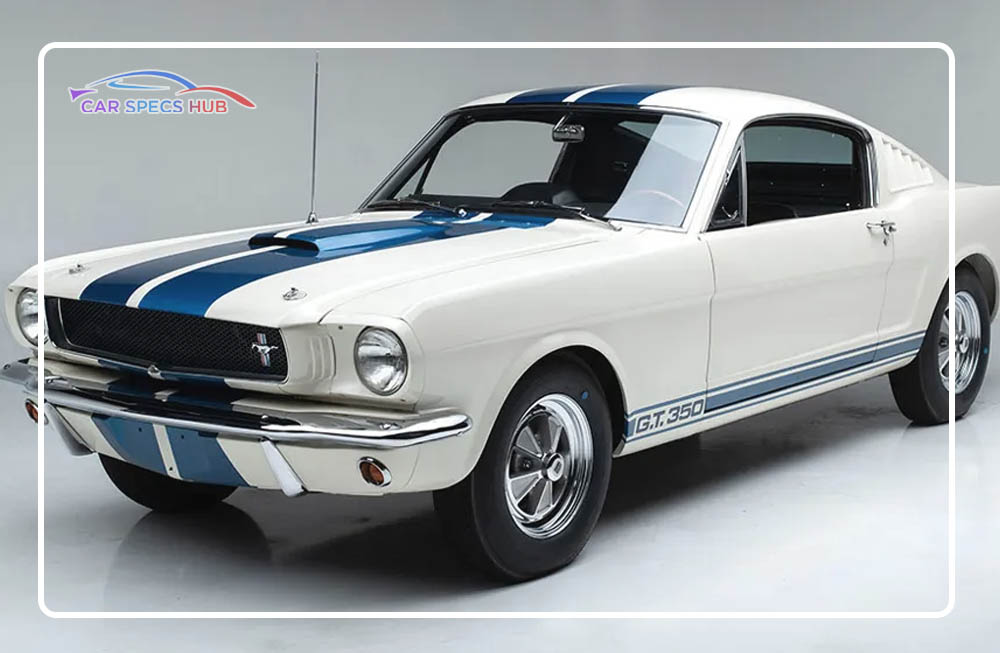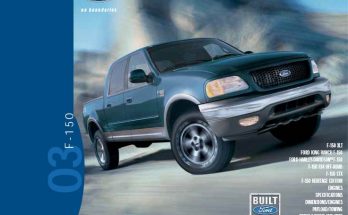
The 1965 Ford Mustang Shelby GT350, a high-performance version of the Ford Mustang, was created by the legendary Carroll Shelby in collaboration with Ford. The GT350 was designed to dominate the racetrack while remaining street-legal, cementing its status as one of the most iconic muscle cars of all time. Only 562 units were built, making it highly sought after by collectors.
Overview
| Feature | Details |
|---|---|
| Production Year | 1965 |
| Manufacturer | Shelby American (in partnership with Ford) |
| Body Style | Fastback |
| Market Impact | Dominated SCCA B-Production racing; now a collector’s icon |
Engine Specs and Features
| Feature | Details |
|---|---|
| Engine Type | 289 cubic inch (4.7L) V8, “K-code” Hi-Po |
| Horsepower | 306 hp @ 6,000 rpm |
| Torque | 329 lb-ft @ 4,200 rpm |
| Compression Ratio | 10.5:1 |
| Carburetor | Holley 715 CFM 4-barrel |
| Transmission | Borg-Warner T-10 4-speed manual |
| Exhaust System | Dual side-exit exhaust |
| Cooling System | High-capacity radiator |
| Drive Type | Rear-wheel drive (RWD) |
Performance
| Feature | Details |
|---|---|
| 0-60 MPH | ~6.5 seconds |
| Quarter Mile | ~15 seconds |
| Top Speed | ~130 mph |
| Suspension | Modified for track use (stiffer springs, larger sway bars) |
| Brakes | Front disc brakes, rear drum brakes |
Fuel & MPG
| Feature | Details |
|---|---|
| Fuel Type | Premium gasoline |
| Fuel Tank Capacity | 16 gallons |
| MPG | ~10-15 mpg (performance-oriented driving) |
Dimensions
| Feature | Details |
|---|---|
| Length | 181.6 inches |
| Width | 68.2 inches |
| Height | 51.0 inches |
| Wheelbase | 108 inches |
| Curb Weight | ~2,900 pounds |
Safety Features
| Feature | Details |
|---|---|
| Brakes | Front disc brakes (standard), rear drum brakes |
| Seat Belts | Lap belts (standard) |
| Body Construction | Reinforced unibody |
| Lighting | Sealed-beam headlights |
| Roll Bar | Included in competition models |
1965 Ford Mustang Shelby GT350 Interior Features
| Feature | Details |
|---|---|
| Seating Capacity | 2 passengers (rear seat delete for weight savings) |
| Upholstery | Black vinyl |
| Dashboard | Simple, driver-focused layout |
| Gauges | Tachometer and speedometer prominently displayed |
| Steering Wheel | Wood-rimmed 3-spoke Shelby design |
| Floor Mats | Shelby-branded (optional) |
| Roll Bar | Standard in some models |
Exterior Features
| Feature | Details |
|---|---|
| Body Style | Fastback |
| Paint | Wimbledon White with blue Le Mans racing stripes |
| Hood Design | Fiberglass with functional scoop |
| Badging | “GT350” emblems and Shelby Cobra logo |
| Wheels | 15-inch steel wheels with Goodyear Blue Dot tires |
| Windows | Manual crank-operated |
| Additional Features | Functional side vents, lightweight aluminum panels |
Current Price in U.S.
| Condition | Price Range |
|---|---|
| Excellent (Restored) | $400,000 – $750,000 |
| Good (Well-maintained) | $300,000 – $400,000 |
| Fair (Functional but Worn) | $200,000 – $300,000 |
| Poor (Needs Restoration) | $150,000 – $200,000 |
The 1965 Shelby GT350 was a race-bred Mustang, blending raw performance with an aggressive aesthetic. Designed for track dominance and street appeal, it featured a high-output 289 V8, race-inspired suspension, and a stripped-down interior for weight savings. Today, the GT350 is a cherished classic, prized for its historical significance, rarity, and thrilling driving experience.
How the 1965 Shelby GT350 Took the Mustang from Street to Track
When the Ford Mustang burst onto the scene in 1964, it was an instant hit. This affordable, stylish, and highly customizable car captivated young Americans yearning for freedom on the open road. Yet, despite its sporty looks, the early Mustang wasn’t a true high-performance machine – until Carroll Shelby got his hands on it in 1965.
The result was the Shelby GT350, a raw, track-bred evolution of Ford’s popular pony car. This wasn’t just an upgrade; it fundamentally redefined the Mustang’s capabilities, blending race-winning DNA with road-going muscle. The 1965 Shelby GT350 transformed a stylish cruiser into an undisputed performance legend.
Let’s explore how this iconic vehicle took the Mustang from street to track, sparking a new era of American high performance.
Carroll Shelby: The Man Ford Needed
Why did Ford enlist Carroll Shelby? By the early 1960s, Shelby was already a revered figure. This former race car driver, turned innovative builder, gained fame by shoehorning powerful Ford V8 engines into British AC cars to create the legendary Shelby Cobra. The Cobra’s brutal performance and racing triumphs made Shelby a household name among automotive enthusiasts.
Meanwhile, Ford’s Mustang was breaking sales records. However, it lacked credibility on the racetrack. Lee Iacocca, the visionary “father of the Mustang,” sought a version that could dominate in the SCCA B-Production class. His solution? Turn to the master – Carroll Shelby.
Shelby’s mission was clear: transform the Mustang into a race-winning machine, and do it quickly.
The Transformation: From San Jose to Shelby American
Shelby’s team began with Wimbledon White Mustang fastbacks, equipped with the potent 289-cubic inch “Hi-Po” V8. These vehicles were shipped directly from Ford’s San Jose plant to Shelby American’s facility in Venice, California, where they underwent extensive modifications.
Here’s how a standard Mustang became the formidable 1965 Shelby GT350:
Engine & Performance Unleashed:
- 289 High-Performance V8 (K-Code): While retaining the factory 289, Shelby meticulously upgraded it with a Holley 715 CFM four-barrel carburetor, an aluminum intake manifold, tri-Y headers, and a high-flow exhaust system. This boosted horsepower from a respectable 271 hp to a thrilling 306 hp.
Side-Exit Exhausts: Not just for show, these loud, aggressive dual pipes significantly reduced back pressure while adding an unmistakable visual and auditory flair.
Enhanced Cooling: An aluminum oil pan and a larger radiator were installed to manage heat under extreme track conditions.
Drivetrain & Precision Suspension:
- 4-Speed Manual Transmission (Borg-Warner T-10): A close-ratio gearbox paired with a heavy-duty clutch ensured crisp, responsive shifts for high-speed driving.
- Detroit Locker Differential (Optional): This upgrade provided superior traction, especially crucial for competitive track performance.
- Advanced Suspension Tuning: Shelby radically reworked the front suspension, incorporating stiffer springs, Koni adjustable shocks, and a larger front sway bar. A critical modification was relocating the upper A-arms, drastically improving front-end geometry and cornering stability.
- Rear Traction Bars: Added to effectively reduce debilitating wheel hop during aggressive acceleration.
- Wheels, Brakes, and Grip:
- 15” Kelsey-Hayes Steel Wheels with Goodyear Blue Dot Tires: These provided significantly better grip and a more aggressive stance than the standard Mustang’s tires.
- Front Disc Brakes: A vital upgrade over the stock drums, providing the necessary stopping power for serious track use.
- Strategic Weight Reduction & Interior Refinements:
- Performance was paramount, so every unnecessary ounce was scrutinized:
- Removed Rear Seats: Early GT350s featured a fiberglass tray in place of the rear bench, transforming it into a strict two-seater to comply with SCCA racing regulations.
- Spartan Interior: Power steering, air conditioning, and excessive trim were eliminated for maximum weight savings and a minimalist, race-focused cabin.
- Race-Ready Cockpit: A dash-mounted tachometer and a special Shelby steering wheel enhanced the performance-oriented feel.
- Fiberglass Hood: Lightweight and functional, with an integrated scoop to optimize airflow to the engine bay.
These meticulous modifications resulted in a GT350 weighing approximately 2,800 lbs, giving it an impressive power-to-weight ratio that rivaled or surpassed many European sports cars of its era.
The Legendary GT350R: Born to Dominate the Track
While the street-legal GT350 was potent, Shelby harbored even grander ambitions. He conceived the GT350R, a purebred race car designed for ultimate track domination.
Only 36 GT350R models were produced in 1965, featuring:
- Full roll cages
- Lightweight Lexan windows
- Elimination of sound insulation
- Further revised suspension tuning
- Engine output exceeding 350 hp
The GT350R made its SCCA B-Production debut and instantly triumphed, winning its very first race at Green Valley Raceway in Texas, driven by another Shelby legend, Ken Miles. This car went on to dominate its class, outperforming formidable competitors like Corvettes, Jaguars, and even purpose-built race cars. It marked the first Mustang victory on a road course, laying crucial groundwork for Ford’s extensive motorsport endeavors in the late 1960s.
Elevating the Mustang’s Image: A Halo Car’s Impact
Ford never expected the GT350 to be a mass-market seller; it was a halo car, meticulously crafted to imbue the Mustang with genuine performance credibility among enthusiasts. Only 562 street versions of the GT350 were built in 1965.
However, its impact was seismic:
- The Mustang’s reputation transformed overnight from a “secretary’s car” to a legitimate, high-performance machine.
- It directly inspired the development of other iconic high-performance pony cars, including the Camaro Z/28, Firebird Trans Am, and subsequent Mustang GT models.
- It attracted a new demographic of buyers – young enthusiasts craving a car with superior handling, cornering prowess, and competitive spirit.
The GT350 conclusively proved that the Mustang was about more than just good looks; it was about raw speed, precise handling, and a rich motorsport heritage.
Iconic Aesthetics: Wimbledon White and Guardsman Blue
All 1965 Shelby GT350s were painted a distinctive Wimbledon White and offered with optional Guardsman Blue Le Mans stripes. The “GT350” name itself, according to legend, carried no hidden meaning; Shelby simply liked its sound, and it reportedly marked the distance in steps from his office to the assembly area. Classic Shelby.
The Enduring Legacy of the Shelby GT350
Today, the 1965 Shelby GT350 stands as one of the most coveted and valuable American collector cars ever produced.
- Well-documented examples routinely command over $300,000.
- Rare GT350R models have fetched over $1 million at auction.
- The car remains a highlight at premier automotive events like Pebble Beach, SEMA, and Barrett-Jackson.
Beyond its monetary value, the GT350 forged a performance subculture that thrives to this day. Every modern Shelby Mustang, from the potent GT500 to the agile Mach 1, traces its performance DNA back to this original street-to-track monster.
Driving the Legend: The 1965 GT350 Experience Today
Driving a 1965 Shelby GT350 is a visceral, unfiltered experience unlike any modern sports car. There are no electronic aids – no traction control, no ABS, no stability systems. Every input from the driver is amplified and immediate.
- The clutch is heavy, and gear shifts are intensely mechanical.
- The engine roars to life, and the side-exit exhaust crackles with an aggressive symphony.
- It is raw, loud, fast, and undeniably thrilling.
It’s not about comfort or quiet refinement. It’s about a Mustang stripped of unnecessary luxuries and infused with an abundance of pure, unadulterated attitude.
Final Thoughts: The Birth of a Performance Icon
The 1965 Shelby GT350 was far more than just a faster Mustang. It was a bold vision brought to exhilarating life by Carroll Shelby – a car capable of winning races on Sunday and providing an adrenaline rush on the street on Monday.
It marked the dawn of a golden era in American performance, where raw muscle seamlessly integrated with motorsport pedigree. The Shelby GT350 solidified the Mustang’s place in history, not merely as a sales success, but as a genuine, track-dominating competitor.
Over half a century later, the legend persists – not just in pristine garages and auction blocks, but in the very DNA of every performance Mustang bearing the iconic Shelby name. Once Carroll Shelby put his indelible stamp on the Mustang, it was forever transformed.




2 Comments on “1965 Ford Mustang Shelby GT350 Specs, Price”
Comments are closed.